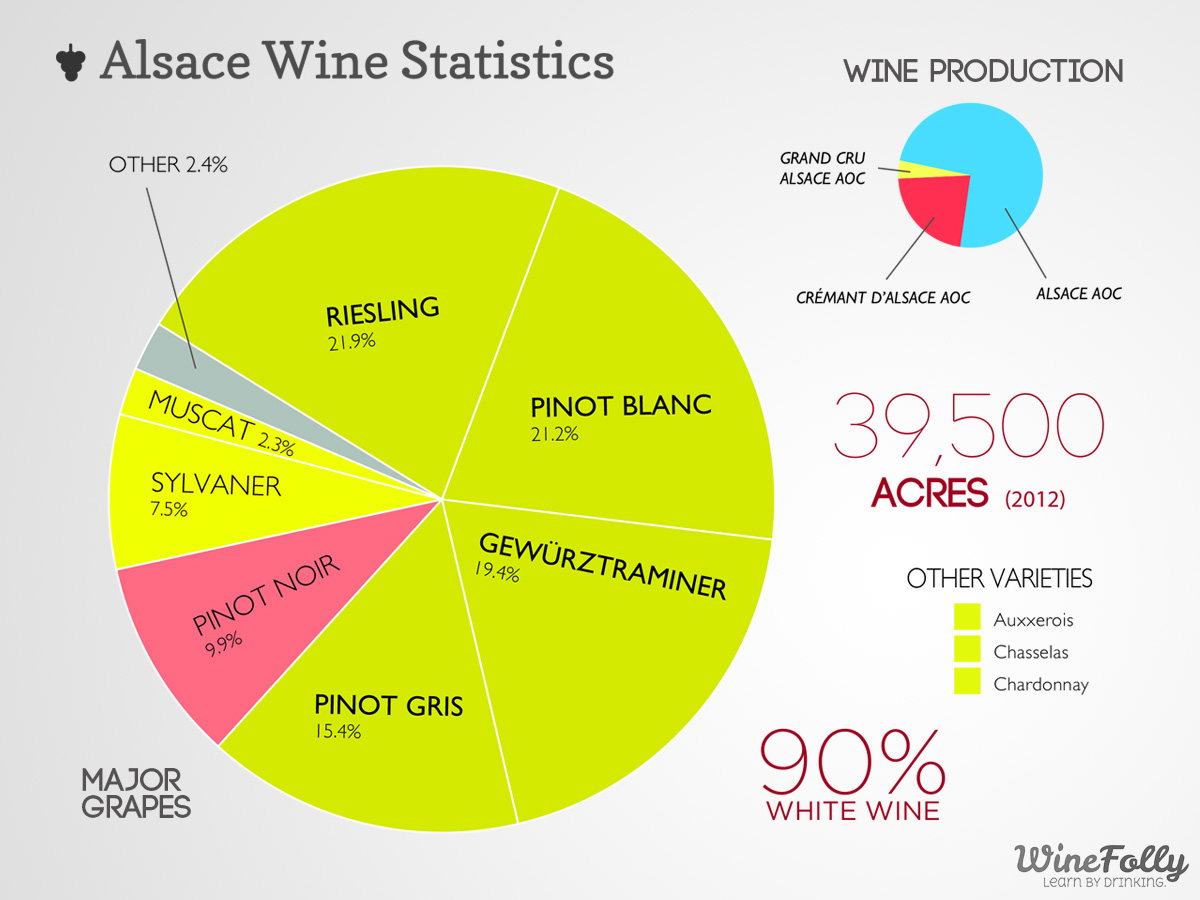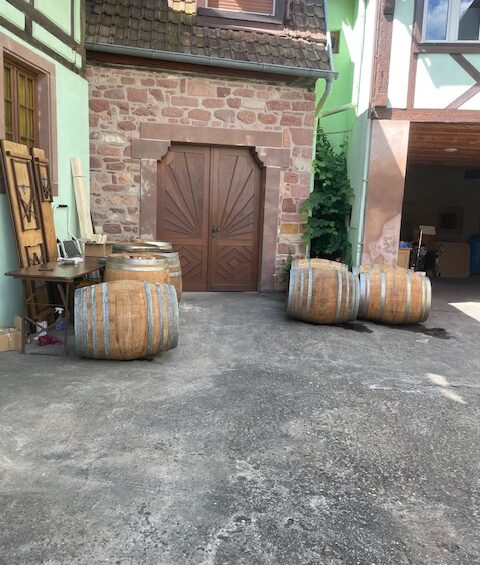Julie Drysdale
Julie is a France 44 WSET 2 and WSET 3 graduate who lives in Golden Valley with her husband Mike. They have 3 adult children who enjoy tagging along on their mom’s wine travel adventures whenever they can.
The first week of June, our great friends’ son got married in a castle in the Netherlands. Since no trip to Europe should go without a wine tangent, northeastern France called. In my WSET classes, we learned about important wine regions all over the world, including Alsace AOC, which is described as a sunny little haven on the border between France and Germany, between the Vosges Mountains and the Rhine. The Vosges Mountains block the rain from the north, and the eastern slopes forms the stunning 90-mile Alsatian Wine Road. The region offers the best of two countries & two cultures in many many stunning glasses of wine.
We started our trip in Strasbourg. We explored the city in the afternoon – the Old Town, the Cathedral and Museum — then our wine adventure started with happy hour at a local wine bar.
As a bit of background – Alsace is the region of the Riesling. If you think of Riesling as a sweet wine, this is the region to prove you wrong and offer some of the world’s most stunning examples of dry riesling. But it’s also so much more than that.

The four ‘noble grapes’ of Alsace are: Riesling, Pinot Gris, Gewurtztraminer, and Muscat. But vin d’Alsace can also be made from Sylvaner, Pinot Noir, Pinot Blanc, Chasselas and Auxerois. And there is Chardonnay grown in the area for Cremant d’alsace (sparkling). Cremant came on the scene in Alsace about 20 years ago, and it’s made in the same method used to produce Champagne. All this to say, it’s a robust wine region, full of innovation.

Our first tastes of wine in Alsace were two crémants: a Pinot Noir and a Grand Cru (designated wine classification) Pinot Gris. Both were excellent. In particular, the Pinot Gris was intensely fruity and full bodied – likely due to the Alsatian sun and Grand Cru vineyard location. The Pinot Noir was full of cherry notes – somewhat like an Oregon or burgundy Pinot Noir, but more fruit driven and less earthy/woodsy. We had dinner at a place called L’eveil de Sens – recommended by a fellow WSET buddy – with another bottle of Pinot Noir! Though this is largely a region of white wine, Pinot Noir is still prevalent and very good!

The next day we took an Alsace Wine Discovery Tour with a company called Ophorous. Our guide, Maxime, was a well-traveled young man with Ukrainian and Portuguese passports and many, many stories. He explained that Alsace has gone back and forth between the French and German borders for centuries. In fact, during World War II, Germany annexed Alsace and declared the Alsatian people to be de facto German citizens who fought for Nazi Germany – a fact that the Alsatians are, understandably, quite sensitive about. Maxime also introduced us to a grape called Klevener de Heiiigenstein. Fromthe vineyard we could see the Vosges Mountains, the Rhine river and the Black Forest in Germany.

Most of our tour time in Alsace was spent in a little town called Barr. We visited the Vincent Stoeffler winery, a small family winery that doesn’t export much, but makes a lot of really interesting wines from the noble and other Alsace grapes. In addition to the regional basics such as Crémant, and Riesling – they make orange wine with Pinot Gris and another orange wine from Gewürztraminer grapes. The latter is said to be a great pairing with Indian food! We also visited Domaine Zeyssolff much bigger and more commercial winery – though still most of their wine is consumed in Alsace. We tasted a very similar line-up of wines from the noble grapes plus a Crémant. Crémant is popular here and clearly was a favorite amongst our tour group! In fact Crémant today makes up 25% of the wine production in Alsace.
All of the wines we tasted were unique, delicious and unexpected. The Muscat and Pinot Gris lean toward stone fruit aromas and flavors. The Riesling is smooth and dry with notes of apple and lemon. Many of the wines made from Muscat, Gewurtraminer and Pinot Gris were notably aromatic, a characteristic brought out by the sunny climate in the region. Everything we sampled had excellent pairing possibilities – many would go great with Indian or Indonesian food.
And because of the dry, sunny, climate, Alsace has long been a pioneer of organic farming so most of the wines we had were organic!
As with much of Europe, many of the wines in Alsace are hard to find outside the region, harder still outside of France, and seldom in the U.S. So my goal was not only to enjoy the wines in Alsace, but also to find comparable bottles I could buy back home.
The Alsatian wines we usually see here in the U.S. and at France 44 – big names such as Trimbach and Hugel – export much greater volumes. In fact, we heard that Trimbach exports nearly 90% of their volume!
We rented a car and drove south where we visited some of these larger wineries. Trimbach is in the magical small town of Ribeauville and Hugel is in another delightful village called Riquewehr. Riquewehr is known for its lineup of wineries right in the main part of town – you can walk from winery to winery to taste. We tasted at a place called Dopff, which was credited with starting the Crémant movement in Alsace. We spotted the Albert Boxler winery, which makes some very good wines that are exported to the US and sometimes available at France 44 (I love their Edelzwicker).
If at this point, as I hope you are, you’re convinced and ready to try some Alsacian wine, here are a few favorites you can find at France 44:

Trimbach Pinot Blanc Alsace 2022

Gustave Lorentz Cremant d'Alsace Brut NV
The balance and freshness of this Cremant d’Alsace come from the subtle match of three grape varieties: Chardonnay for its vivacity & fruit, Pinot Blanc for its refined elegance and Pinot Noir for its persistence and subtle dark fruit.

Bott-Geyl Alsace Metiss 2022
This white blend is crisp and approachable. On the nose, it unveils a bouquet of ripe fruits and citrus, interwoven with hints of white blossoms. On the palate, it is light and invigorating, with a harmonious acidity that accentuates its fruity essence.
Our final stop on the journey was to see the town of Colmar. No wine tasting here, but we did spot a full Trimbach line up I the window of a wineshop – including their iconic Clos St. Hune Riesling available for a mere 289 Euros! Colmar also has a claim to fame as the inspiration for the buildings and town in the gorgeous Miyazaki Japanese Anime film Howl’s Moving Castle.
Leaving Alsace, we headed toward Metz, France via a beautiful drive through the Vosges Mountains. We’d hoped to visit Maison Lelievres – winemaker David Lelièvre was recently at France 44 for a pop-up tasting. But unfortunately, rain and time got in the way of this plan!
From there – on to Luxembourg and our ultimate destination the wedding in Maastricht Netherlands. Overall, I would highly recommend a visit to Alsace and Lorraine. The countryside and towns are beautiful, sun-drenched but not scorching, and an excellent area to try an array of interesting and mostly reasonably priced white wines!
